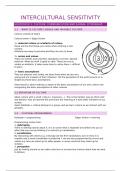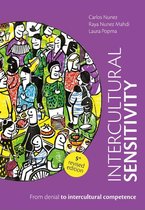INTERCULTURAL SENSITIVITY
HOOFDSTUK 1: CULTURE, COMMUNICATION AND GLOBAL CITIZENSHIP
1.1 WHAT IS CULTURE? VISIBLE AND INVISIBLE CULTURE
Culture consists of layers
Cultural onion-> Edgar Schein
1= material culture or artefacts of culture
these are the first things you notice when entering a new
country.
Artefacts are easy to perceive and they are nice to know.
2= norms and values
These are written and unwritten standards of correct, desired
behavior. What we think is good or right. These are not as
visible as artefacts, it takes some time to notice them + difficult
to learn.
3= basic assumptions
They are abstract and visible, we learn them when we are very
young and are unaware of their influence. Yet the perception of the world around us is
shapes by these basic assumptions.
Intercultural is about making us aware of the basic assumptions of our own culture and
recognizing the basic assumptions of other cultures
1.2 DEFINTION OF CULTURE
About culture with a small c (big C= museums,…). This is the familiar way we think, feel
and behave. How we learned this and share the meaning of it with other members of our
society
Geert Hofstede-> culture belongs to a group, and we learn culture as we interact with our
group(s).
1.3 CULTURAL PROGRAMMING
Hofstede-> programming Edgar Schein-> learning
Programming comes from:
1: upbringing
There is nothing natural about it. It is an action that is repeated and drilled into you so
often that you end up thinking it is normal e.g. handshakes
2: socialization
By interacting with others e.g. in Europe we like firm handshakes, but in China it is
impolite and a looser handshake is preferred + we are also programmed by norms and
values e.g. here we stand up for older people, in some countries they stand up for
children.
3: perception
Just by looking around us we make conscious or unconscious choices about how we want
to behave.
,STILL every person is a unique individual and makes choices
There are 3 levels of programming
Individual
Cultural
Human nature
1.4 CULTURE AND SUBCULTURES
“culture is the collective mental programming of the mind”
-> collective=the group or subgroup we belong to, a person belongs to several subgroups
e.g. a continent, ethnic, religion, gender, hobby, profession, corporate,..
Different subcultures have differences, similarities and overlaps
culturally diverse teams are the worst and the best: if left unmanaged and cultural
differences are ignored ->
a lot of problems understanding each other + coming to an agreement
if managed, trained in intercultural sensitivity and differences are appreciated -> most
creative, effective and dynamic teams
1.5 INTERCULTURAL COMMUNICATION
Communication = the exchange of meaning, ALL communication takes place within a
context e.g. family, business
Process of communication
1 source: you give the information to a person
2 information is encoded by using appropriate language, gestures or nonverbal
expression
3 this information is transmitted through a channel -> the medium e.g. in face-to-face it’s
the air, written it’s a paper, email
4 receiver decodes your message and responds (again encoding, you decode it again)
Intercultural communication= communication between sources and receivers from
different cultures.
-> good communication requires intercultural competence e.g. cultural knowledge
-> culture has impact on every
stage in the process of
communication
> e.g. you can mean something
good, but your way of saying it can
be understand wrong in another
culture.
, 1.6 NOISE. WHAT EXACTLY IS COMMUNICATION NOISE
= anything that distorts or blocks the message, that distracts the receivers or causes
them not to understand the message.
-external noise/physical noise: interference from the environment e.g. people next to
you talking loudly
-internal noise/psychological noise: emotions, worries or personal prejudices that get
in the way of paying attention.
-> emotions: angry, sad or worried(in class e.g.)/ being head over heels in love
-> prejudices and biases: e.g. a biased observer watching a good presentation of a
student with a head scarf will not hear or appreciate her presentation on account of
personal preconceptions about her scarf.
-cultural noise: differences in cultural programming distort the message e.g. the
appropriate amount of eye contact might be too much for another culture. -> TOPOI
resolves cultural noise
1.7 TOPOI MODEL, INTERVENTION FOR CULTURAL NOISE
= Edwin Hoffman
T= Tongue or language
It is about meaning, the language aspect:
-> verbal language: well documented meanings, and one word can have different
meanings. Which can causes misunderstanding for native- and non-native speakers.
-> nonverbal language: not formally documented in dictionaries, and can differ greatly in
meaning and interpretation.
! as an intervention, always consider that words and nonverbal language can have
several meanings. Ask and give feedback
O= Order
It is about the participant’s view. How do they view, order and organize reality? Everyone
has their own views on reality, and their own ‘logic’. We have different frames of
reference. What makes sense to you may not seem so logical to another person.
! there is never one truth or reality
P= Persons
The relationship part of the conversation, the relationship can determine or alter the
meaning of what is being said.
-> symmetrical relationships: these are between equals, like between friends, brothers or
sisters, fellow team members,…
-> complementary relationships: these are between people at different levels of
authority, like between teachers and students, parents and their children, team leaders
and team members,…
O= Organization
The social and professional organizational context of the communication. Organizational
structures that are unfamiliar to us can be the cause of misunderstanding e.g. we + the
Netherlands have ‘een huisarts’ as the central point between you and any other
specialist.





